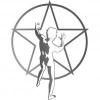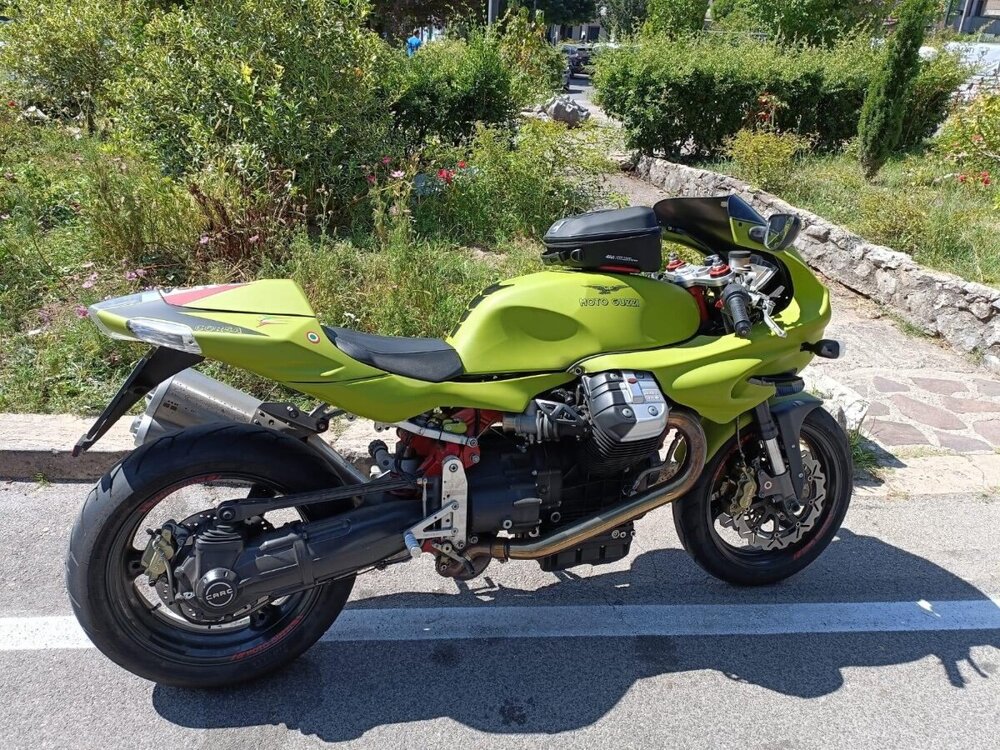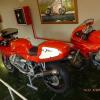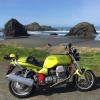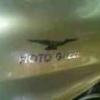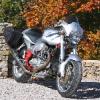Leaderboard
Popular Content
Showing content with the highest reputation on 08/30/2023 in all areas
-
4 points
-
The plug colour is almost totally dependent on the way you operate the engine. Lots of cold starts and short commuting trips and they will always be sooty with the std heat range. Flogged mercilessly and they will be clean. Plugs readings on a commuter bike is fraught with complications. Thats why race bikes did plug chops in the old days at the end of the practice session with a full throttle blast down the straight and race engines with 1000klms on them look clean as a whistle inside. Phil3 points
-
Mine doesn't rub, but the bracket on the left is closer to the tank than on the right. I think it might have to do with the left cylinder being further back than the right, but I didn't have enough time to have a really close look at it after I noticed the "problem". I have been informed by someone who really knows what he is talking about that there can be problems with contact between fairing, sidecovers and tank, and ensuing wear and tear. He suggested a thick washer or two under the rear mount of the tank to raise it a couple of millimeters. I haven't had a really close look yet to see exactly what it will acheive, but the first glance indicated that this might be a really good idea.3 points
-
Yes commonly done. On my bike the bush is about 15mm high but my fwd tank mounts have been raised 38mm. A 2 valve V11 would be less. Keeps the tank sides off the side covers. Phil2 points
-
Said m times before. See your ex valve goes down and up, intake valve down and up. Piston at tdc. Straw useful just before tdc. Clockwise only. Cheers Tom.2 points
-
If anybody was interested, they have reduced the ask price by 1000; https://www.cycletrader.com/listing/1993-Moto+Guzzi-DAYTONA+1000-5022866829?zmc=PriceAlert-ADDetail-btn1 point
-
Amazon has always been my last resort. To the extent that I honestly believe that I have never bought anything from Amazon. anyway, the pertinent question of the moment seems to me to be this one:1 point
-
I took off my seat to check the tank's fastener and found it unscrewed. The head was clearly off the large washer, allowing the tank to move laterally. I guess this was the root cause of the problem as when I removed the fairing to change the head lamp, I did not notice anything wrong with the tank being armed by the support on the left side. Don't know how that screw could become that loose.1 point
-
1 point
-
1 point
-
My guess is it a Griso CARC bike with a Aprilia Tuono rear sub frame and body work, added to a Sport100 Tank and fairing. It somehow also looks to be housing a red spine frame and Griso muffler. The wave front rotors, Aprilia dash and custom rear sets to top it off. A Tuono Griso Sport1100, I like all of those bikes so I guess by default I like this invention.1 point
-
That looks to be a spine frame Sport with a fairly modern 8 valve CARC motor (like from an 8 valve Griso) stuffed into it. Tricky in part because the alternator of the modern motor is up front between the cylinder heads, driven by a belt as I recall, which would likely be in the way of the spine frame. The Sport was before the V11 Sport, between it and the Daytona. Think of it as a Daytona with a V11 motor but the older 5 speed trans. Impressive. I wonder if they switched from the belt drive alternator to one mounted directly on the end of the crank.1 point
-
I lot of noise in the classic bike world about the loss of Avon. This is great news, especially if we can still get the Roadrider 2.1 point
-
1 point
-
Please understand that Amazon sells cheap , not quality . Make sure about what you are buying1 point
-
From all of that, I really like this one the best. Mostly because I can't fathom WTF is going on. At all . . .1 point
-
Have a listen to this woman. I heard her a couple of months ago. Fairly young, and quite brilliant. Unfortunately the recordings here are a bit shitty. https://www.bryndisgudjonsdottir.com/media1 point
-
Yes, exactly. Getting the alternator cover off is complicated on mine, as I have the crossover between the headers which sits in front of the alternator cover. Nevertheless, I prefer a spanner (socket) on the alternator to turn over the motor. Whatever the method is to turn over the motor, the straw is very useful. Actually, I prefer to use a piece of heat shrink tube. Because: it happens to be lying around in easy reach of the work bench, it is soft enough to not damage anything inside the motor, and tough enough to not get chewed up if it does get jammed in there a bit. The "straw" is useful because it means I can be watching the valves whilst turning the motor with one hand and feeling what the "straw" is doing with the other. I turn the motor until it gets to TDC. Generally it kind of pops past the precise point. I've always assumed that this has to do with what the valve springs on the other piston are doing. So, I go back a bit and approach the point again. I have observed where I was at with the spanner on the alternator and what the straw was doing, and can find the TDC on the second approach very precisely. By the way, the reason for always approaching the TDC in the correct direction of motor rotation is to ensure that all the slop in the cam chain and so on is being taken up be the tensioner in the way the manufacturer intended, i.e. any backlash or whatever is there where it will be at when the motor is really running. Seems logical to me...1 point
-
Thing is, since the adoption of crank/cam triggered timing sensors the marks are essentially completely irrelevant. You can establish top dead centre, or close enough to set valve lash, by observation or, if you've done it a few times, simply by *feel*. All that is required is the cam lobes be on the base circle while you are checking the clearances. What are the clearances for after all? On bikes with points or a distributor of some sort you needed to know where TDC was and where the static and full advance marks were on the flywheel when you were strobing them but since the advent of electronic ignition and ECU's all that is unnecessary because all the needed data for engine management vis-a-vis spark and injection timing is controlled by a phase wheel behind the cam sprocket,(On V11's and the like. Why the persisted on still marking the flywheels right up until the advent of the CARC bikes I have no idea? Force of habit probably! Ignore any marks. They are utterly irrelevant!1 point
-
I had no issues turning the motor by the rear tire, just use 5th or 6th gear with both sparkplugs out and it makes it very easy to turn (leverage is your friend). Using the rear tire also makes it easy to make sure you turn the motor the right direction (you don't want to turn the motor backwards for any of this). I also had no issues using a straw to feel for the piston. In fact, I have never used the markings on the flywheel for any of this. Not sure if the markings are even there. I don't like sticking solid objects down the sparkplug hole, I prefer things like straws that will give if things go sideways. A straw can't mess anything up.1 point
-
Engine temperature sensor. It's the blue thing screwed in to the back of the RH cylinder head in a plastic holder.1 point
-
I'll wait for Chuck to present this D-S translation in 'merican English . Indeed the "S" is Italian for left. And +1 on fussing with the alternator cover. Mine is made more complicated by aftermarket FIAMM horns (they are worth the trouble!). Also, be aware of the compromised strain relief of the alternator wiring that must be removed, and refitted, to the top of the cover. Stator failure, and problematic voltage spikes, can result from carelessness or neglect. Inspect your stator wiring and restore the strain relief any time the cover is off. Use a black "zip-tie" instead of the white. The carbon content makes them more durable. I know to turn the motor in its normal rotation, clockwise looking from the front, and even scribed some arrows on the stator face as a reminder. The marking for the right cylinder ("D") is either 90º or 270º from the "S" and I can never remember which cylinder fires "first" and how far to the next. As in: If you find the "S", how far to rotate (clockwise) to the "D?" 90º or 270º? The angle of view through the inspection hole to see these markings is not intuitive. A good light and a lift are quite helpful. Also, the crankshaft counterweights tend to spin the crankshaft suddenly during rotation and fly past the next mark. All of this rotation is best accomplished with the spark plugs removed to eliminate the effects of the compression. While some might say the "D" is Italian for "Destro", I feel certain mySport's marking is "Destra" . . .1 point
-
Yes, that is correct. I did the valve clearances on mine recently, and found a mark for TDC for the left cylinder. I don't remember what it was, though. I'm not quite sure, but I reckon I didn't find a mark for the right hand cylinder. Should be easy to check though: with the rocker covers off, watch what the valves are doing. Find the combustion TDC, go back a bit, and turn the motor slowly past the TDC whilst keeping an eye on the flywheel through the hole. That's how I found the mark for the left cylinder. The most difficult part of the process was getting the cover off the alternator to be able to put a spanner on the front of the motor and turn it over in a controlled fashion. What a pain in the proverbial...1 point
-
Lindy??? Geeeeess .....Chuck please don't fly that thing from Elwood, Indiana to Paris, France.1 point


